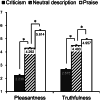More Exposure to Childhood Trauma Associates with Reduced Displeasure at Self-Referential Criticism
- PMID: 35958712
- PMCID: PMC9360388
- DOI: 10.1007/s40653-021-00429-y
More Exposure to Childhood Trauma Associates with Reduced Displeasure at Self-Referential Criticism
Abstract
Childhood trauma has been shown to contribute to low self-concept, potentially affecting trauma survivors' perception of social evaluations from others. However, there is little evidence for the association between traumatic experience in childhood and adult processing of evaluative verbal cues related to self. Therefore, the present study aimed to address whether and how cognitive and affective responses to self-referential praise and criticism would vary with different forms of childhood trauma. We engaged undergraduates and postgraduates in completing the Childhood Trauma Questionnaire (CTQ) and an evaluation task in which participants rated self-related praising and criticizing sentences for pleasantness and truthfulness. These ratings and CTQ scores were subjected to correlation and regression analyses. Positive correlations were found between the pleasantness ratings for criticism and the scores of the CTQ full scale (r 90 = .314, p = 0.0011) and two subscales for physical abuse (r 90 = .347, p = 0.0004) and physical neglect (r 90 = .335, p = 0.0005), indicating that higher scores in the scales were associated with reduced unpleasantness for self-related criticism. The regression analysis further revealed that 14.2% variances of emotional response to criticism could be explained by experience in physical abuse (β = .452, p = .022) and physical neglect (β = .387, p = .027). These findings suggest that childhood exposure to traumatic experience, particularly physical abuse and neglect, leads to attenuated emotional responses to self-referential criticism possibly via the mediation of self-concept.
Keywords: Childhood trauma; Criticism; Pleasantness; Praise; Self-concept.
© The Author(s), under exclusive licence to Springer Nature Switzerland AG 2022.
Conflict of interest statement
Conflict of InterestThe authors declare that they have no conflict of interest.
Figures
References
LinkOut - more resources
Full Text Sources


